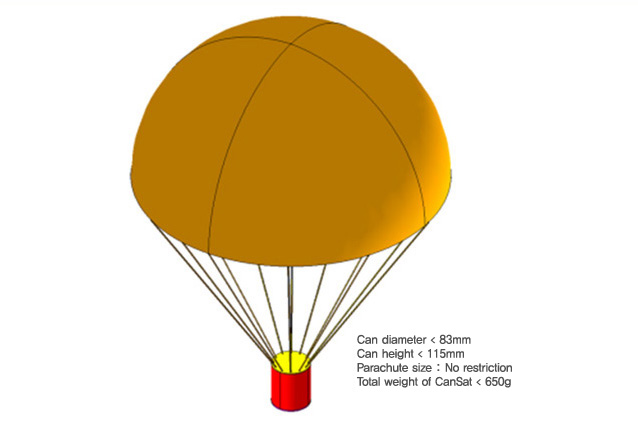(1) Team organization - Fifth and sixth graders of elementary schools in Korea and middle school students are invited for participation, and each team, in principle, must participate under the instruction of a guidance teacher.
(2) CanSat basic kits (goods)/development expenses (cash) - Teams selected after the primary evaluation are provided, free of charge, with CanSat basic kits at the Experience Camp
(3) CanSat education - All teams selected after the primary evaluation are provided with online education via the competition homepage so that they can learn by themselves the knowledge required to make CanSats. (This includes introduction to satellites, how to make CanSat, introduction to international CanSat competitions, principles and application of microprocessors, interface and methods for mission expansion, protocols for transmission and receipt, block diagrams for CanSats, etc.)
(4) CanSat specifications
- Size of the can (container) provided to the Experience Department: Diameter < 83 mm and height < 115 mm. (A can with a diameter of 83 mm and height of 87 mm is planned to be provided at the competition. The walls of the can provided at the competition are made of transparent plastic, and the upper and bottom disks are detachable, making it convenient to make a CanSat.)
 - CanSat weight : Total weight of CanSat including parachute < 600g
- CanSat weight : Total weight of CanSat including parachute < 600g
- Parachute size : No restriction
- Volume of folded parachute : The folded parachute and CanSat must be inserted together into the hexahedron-shaped CanSat loading and detachment device.
(Volume of the CanSat loading and detachment device : 240 x 170 x 150mm3)
- Method of connecting CanSat and parachute : No restriction.
- Conditions for electronics storage : In principle, electronic circuits must be contained in the inside of the can (container), but if necessary electronic parts are allowed to be exposed, fixed, or attached to the outside of the can. However, there must be no mechanical interruptions when the CanSat and parachute are inserted into the CanSat loading and detachment device

(5) CanSat loading and detachment device (Experience Department)
- Using the multicopter with the attached unfolding device shaped like a hexahedron plastic basket.
- When the device rises to the target altitude, its bottom side opens upon command from the ground.
- Size of the unfolding device : 240×170×150mm3

(6) CanSat rockets (provided at the camp)
- Experience Camp participants use the multicopter.
- Participants install the parachute and CanSat to the CanSat loading and detachment device, raise the multicopter to the target altitude (100-200m), and detach the CanSat and parachute via ground command.
(7) Regulations for unfolding parachute - Upon detachment of the CanSat and the parachute from the CanSat loading and detachment device, the parachute must be unfolded immediately. Failure of unfolding parachutes or incomplete unfolding due to breakage of connection lines might cause risks from the free fall of CanSats from a high altitude.
(8) Regulations for realizing CanSat functions
- Power systems : Must be equipped with batteries that supply power necessary for CanSat operation.
- Telecommunication systems : Must be equipped with wireless data telecommunication function between the CanSat and ground station, but there are no particular limitations for the telecommunication protocol.
- Structural systems : Must be able to protect CanSat electronic parts, without structural damage, against the weight loaded onto the CanSat during the course from detachment to ground landing.
- Command and data processing systems : Must collect physical quantities or images measured during the CanSat’s fall and remotely send such information to the ground station.
- Ground stations : Must receive position data (rotation angles) of the CanSat at different altitudes, location data (GPS data), image data obtained on the ground.
(1) Experience Department
- Participants make a CanSat by using the CanSat basic kits at the Experience Camp and carry out a flight and operation mission.
- Participants are encouraged to use the basic functions provided by the CanSat basic kits in carrying out their mission regarding measuring rotation angles, GPS data, and illumination and obtaining ground images.
(1) Evaluation and selection process
- Teams to participate in the Experience Camp are selected after the primary evaluation.
 ※ Primary evaluation
※ Primary evaluation
Applicants are required to suggest a mission by describing team organization and roles, motives for participation, suggestions for CanSat utilization mission, mission goals, development methods, methods of analyzing and utilizing observed data, and methods of publicize performances. Based on the evaluation (document examination) of the suggestions in the application forms, teams eligible for the Experience Camp are selected.
(2) Detailed evaluation criteria
| Examination | Evaluation items | Details | Weight |
|---|---|---|---|
| Primary document evaluation | Mission suggestion | Motives for participation, creativity of mission goals suggested, methods of publicizing the CanSat Competition | 100% |